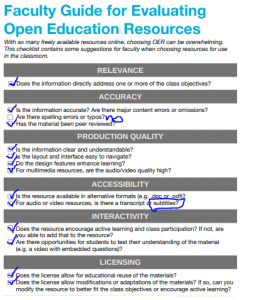• Discuss the difference between online educational content and openly licensed educational content
Openly licensed educational content, or OER (open educational resources) means that educators can share, adapt and edit high quality, free educational resources. Whereas online educational resources are materials that are online but may require you to buy them and has restrictions on how you can distribute and modify the materials. Some examples of OER’s could be notes from a course, textbooks, tests, videos, all of which you could use, edit, distribute to your hearts content. In contrast, an example of an online educational resource could be a worksheet that you purchase off Teachers Pay Teachers. Through purchasing educational tools through Teachers Pay Teachers, the educator only has permission to use the materials with their own class and, typically, does not have permission to edit the material. Another example of an online educational resource is the Smithsonian Education site. When someone puts openly licensed educational resources online, they are released under some type of license which allows whomever is accessing that OER the free use, distribution, modification and sharing. Most importantly, ONLY openly licensed educational resources contain the “5R permissions”, meaning that you have permission from the creator to “retain, reuse, revise, remix and redistribute.” Although not all OER’s are digital, the majority of them are. When searching for openly licensed educational content, educators need to look for the license. One of the most popular open licensing systems is Creative Commons (CC).
• Review the OER using the evaluation guide found in the tutorial, provide a brief comment on this process in your post

The OER that I chose was the website youcubed which is a mathematics website. Upon evaluating this website, it is clear that youcubed is a prime example of what an OER should be as it checked off all the boxes in the evaluation guide. Youcubed website is governed by a “Creative Commons Attribution 4.0 International License”.
It was interesting to go through a website that I have used over the past 3 years to assess if it was a true, authentic openly licensed online educational resource. I never realized how many “boxes” there were to tick off to assess an OER. However, with that being said I am not surprised that youcubed website scored so high as it contained lesson plans, videos for both teachers and students (which included subtitles), access to courses taught by Jo herself, materials for educators to adapt, and much more.
• Discuss how you might use OER in your own life or professional work.
Throughout my past 3 years of teaching my own class, I have seen a shift in how educators use and promote online resources. I myself feel quite confident when searching for OER’s to use in my class, as I have been fortunate to have my coworker show me how to accurately search for material. Through somebody teaching me how to navigate the vast array of educational resources and sites, I have been able to asses which resources are best suited to my needs. Upon my readings this week, I found an article through the Office of Educational Technology (United States of America), that discussed the #GoOpen movement. The #GoOpen movement is “when schools, or school districts, are committed to providing their teachers with quality, licensed educational resources for students and teachers”. I love this idea and have already started to see the #GoOpen movement make its way across the border into B.C.
Within the province of B.C., an online resource site has just been created and will be launched (hopefully) by March 1st, 2020. The resource site, called ShareEdBC Resource Collection, will be available to teachers through their Microsoft Teams account and is designed to be a collection of resources that are classroom ready, aligned with the new curriculum and is adaptable. Just last week, I was asked by my district to put together 10 lesson plans that included some component of technology devices, videos and supplementary materials. Upon creating these lessons, I then uploaded them to the ShareEdBC Resources site. After further inspection, I noticed that the leaders of ShareEdBC Resources use a Creative Commons license which qualifies the materials as OER’s. I am excited to continue exploring the vast array of OER’s that are available.